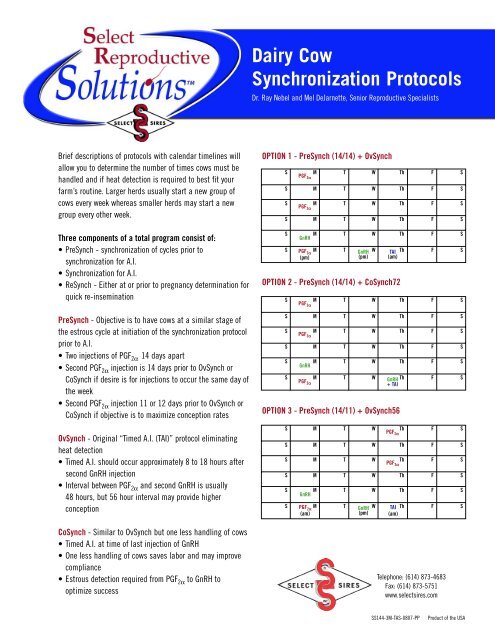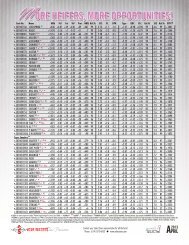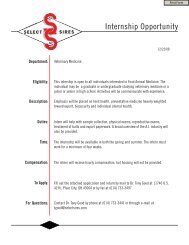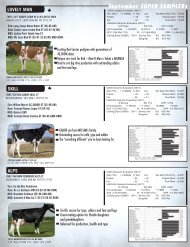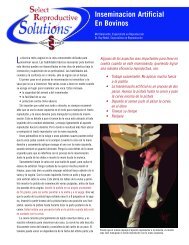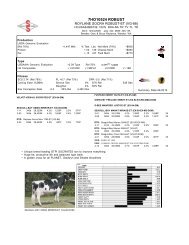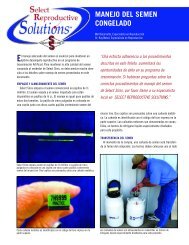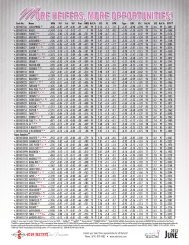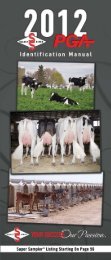Dairy Cow Synchronization Protocols - Select Sires
Dairy Cow Synchronization Protocols - Select Sires
Dairy Cow Synchronization Protocols - Select Sires
You also want an ePaper? Increase the reach of your titles
YUMPU automatically turns print PDFs into web optimized ePapers that Google loves.
<strong>Dairy</strong> <strong>Cow</strong><br />
<strong>Synchronization</strong> <strong>Protocols</strong><br />
Dr. Ray Nebel and Mel DeJarnette, Senior Reproductive Specialists<br />
Brief descriptions of protocols with calendar timelines will<br />
allow you to determine the number of times cows must be<br />
handled and if heat detection is required to best fit your<br />
farm’s routine. Larger herds usually start a new group of<br />
cows every week whereas smaller herds may start a new<br />
group every other week.<br />
Three components of a total program consist of:<br />
• PreSynch - synchronization of cycles prior to<br />
synchronization for A.I.<br />
• <strong>Synchronization</strong> for A.I.<br />
• ReSynch - Either at or prior to pregnancy determination for<br />
quick re-insemination<br />
PreSynch - Objective is to have cows at a similar stage of<br />
the estrous cycle at initiation of the synchronization protocol<br />
prior to A.I.<br />
• Two injections of PGF 2α 14 days apart<br />
• Second PGF 2α injection is 14 days prior to OvSynch or<br />
CoSynch if desire is for injections to occur the same day of<br />
the week<br />
• Second PGF 2α injection 11 or 12 days prior to OvSynch or<br />
CoSynch if objective is to maximize conception rates<br />
OvSynch - Original “Timed A.I. (TAI)” protocol eliminating<br />
heat detection<br />
• Timed A.I. should occur approximately 8 to 18 hours after<br />
second GnRH injection<br />
• Interval between PGF 2α and second GnRH is usually<br />
48 hours, but 56 hour interval may provide higher<br />
conception<br />
CoSynch - Similar to OvSynch but one less handling of cows<br />
• Timed A.I. at time of last injection of GnRH<br />
• One less handling of cows saves labor and may improve<br />
compliance<br />
• Estrous detection required from PGF 2α to GnRH to<br />
optimize success<br />
OPTION 1 - PreSynch (14/14) + OvSynch<br />
S M<br />
PGF 2α<br />
T W Th F S<br />
S M T W Th F S<br />
S M<br />
PGF 2α<br />
T W Th F S<br />
S M T W Th F S<br />
S M T W Th F S<br />
GnRH<br />
S PGF 2α<br />
M T GnRH W TAI Th F S<br />
(pm)<br />
(pm) (am)<br />
OPTION 2 - PreSynch (14/14) + CoSynch72<br />
S M<br />
PGF 2α<br />
T W Th F S<br />
S M T W Th F S<br />
S M<br />
PGF 2α<br />
T W Th F S<br />
S M T W Th F S<br />
S M T W Th F S<br />
GnRH<br />
S M T W Th F S<br />
PGF GnRH<br />
2α<br />
+ TAI<br />
OPTION 3 - PreSynch (14/11) + OvSynch56<br />
S M T W Th<br />
PGF 2α<br />
F S<br />
S M T W Th F S<br />
S M T W Th<br />
PGF 2α<br />
F S<br />
S M T W Th F S<br />
S M T W Th F S<br />
GnRH<br />
S PGF 2α<br />
M T GnRH W TAI Th F S<br />
(am)<br />
(pm) (am)<br />
Telephone: (614) 873-4683<br />
Fax: (614) 873-5751<br />
www.selectsires.com<br />
SS144-3M-TAS-0807-PP<br />
Product of the USA
▼ DAIRY COW SYNCHRONIZATION PROTOCOLS<br />
PGF 2α + CIDR ® Synch - Uses a series of PGF 2α injections<br />
combined with heat detection to A.I. most cows at estrus.<br />
<strong>Cow</strong>s not inseminated at estrus receive a CIDR ® insert<br />
+ OvSynch protocol for Timed A.I.<br />
• One week after last PGF 2α cows not previously inseminated<br />
receive a CIDR ® + OvSynch started<br />
• OvSynch protocol can be either OvSynch, CoSynch72,<br />
or OvSynch56<br />
• Allows for A.I. of cycling cows prior to OvSynch<br />
• Uses a CIDR ® in cows that likely need supplemental<br />
progesterone prior to A.I.<br />
OPTION 4 -PGF 2α + CIDR ® Synch<br />
S M T W Th F S<br />
PGF 2α<br />
Tail Stripe (chalk/paint) and A.I.<br />
S M T W Th F S<br />
S M T W Th F S<br />
PGF 2α<br />
Tail Stripe (chalk/paint) and A.I.<br />
S M T W Th F S<br />
S M T W Th F S<br />
PGF 2α<br />
Tail Stripe (chalk/paint) and A.I.<br />
S CIDR ® M T W Th F S<br />
+ GnRH<br />
S CIDR ® M T<br />
GnRH<br />
W<br />
TAI<br />
Th F S<br />
out + PGF 2α<br />
(pm) (am)<br />
ReSynch - <strong>Cow</strong>s receive Timed A.I. following “open” diagnosis<br />
• Herds with excellent heat detection may choose to initiate<br />
ReSynch at pregnancy exam. (recommended for tail stripe herds)<br />
• Seven days prior to pregnancy exams inject all cows<br />
with GnRH.<br />
• Pregnant cows receive no further injections.<br />
• At “open” diagnosis cows are injected with PGF 2α , GnRH<br />
at 48 hours, and A.I. approximately 8 to 18 hours later.<br />
Voluntary Waiting Period (VWP) - Prevention of excessive<br />
mobilization of body fat in the first six weeks of lactation is of<br />
primary importance for subsequent fertility. <strong>Cow</strong>s will tolerate a<br />
loss of approximately one (1) body condition scoring unit in the<br />
first six weeks after calving; more extreme condition loss will<br />
predispose her to lower conception rates at first service. Body<br />
condition and cyclicity (target 75 percent) should be used as<br />
guides to determine when to set the VWP especially when using<br />
Timed A.I. protocols. Because every cow will be inseminated<br />
within a one week interval post calving, the VWP can comfortably<br />
be set at 70 to 80 days in milk.<br />
Compliance for a synchronization protocol is defined as<br />
the administration of hormones to the correct cows at the<br />
correct time intervals. The more complicated a protocol,<br />
the greater the chances are for procedural failure. Protocol<br />
compliance is critical for success. For example, the standard<br />
Presynch + Ovsynch protocol requires that each cow<br />
receive five hormone injections at appropriate days in milk<br />
and in the correct sequence. Failure to administer any one<br />
of these five hormones or administration in an incorrect<br />
sequence will result in a failure of the protocol to deliver<br />
an ovulated ova following insemination. If at each step a<br />
95 percent compliance is achieved, the cumulative compliance<br />
becomes 77.4 percent which should not be acceptable.<br />
When selecting a synchronization protocol two factors<br />
determine the success of any program - cycling cows in<br />
excellent body condition and compliance to the prescribed<br />
protocol.<br />
WHICH PROTOCOL IS BEST<br />
It is still possible to maintain good reproductive performance<br />
in dairy herds without synchronization and Timed A.I.,<br />
but it requires an effective heat detection program.<br />
Unfortunately, maintaining an efficient heat detection program<br />
and quality heat detection personnel can be a neverending<br />
challenge in today’s expanding herds. As the accuracy<br />
and efficiency of estrous detection declines, the value<br />
of incorporating synchronization and Timed A.I. into the<br />
reproductive management program increases proportionately.<br />
By grouping cows that calve within a one or two week<br />
window, cows can be systematically synchronized to allow<br />
for maximum pregnancy rates and minimal labor inputs. It<br />
is easy to get confused by the variety of protocol available;<br />
however, this variety provides flexibility in developing a tailor-made<br />
reproductive management program. Work with<br />
you veterinarian and <strong>Select</strong> Reproductive Solutions TM<br />
Specialist to design a tailor-made program for your dairy.<br />
GnRH - Cystorelin ® , Factrel ® , Fertagyl ® , and OvaCyst ®<br />
PGF 2α - estroPLAN TM , Estrumate ® , In-Synch ® , Lutalyse ® , and<br />
ProstaMate ®<br />
CIDR ® - Progesterone releasing device<br />
Times listed for Timed A.I. should be considered as the approximate<br />
average time of insemination. This should be based on the number of<br />
cows to inseminate, labor, and facilities.<br />
TM<br />
<strong>Select</strong> Reproductive Solutions is a trademark of <strong>Select</strong> <strong>Sires</strong> Inc.<br />
Telephone: (614) 873-4683<br />
Fax: (614) 873-5751<br />
www.selectsires.com


